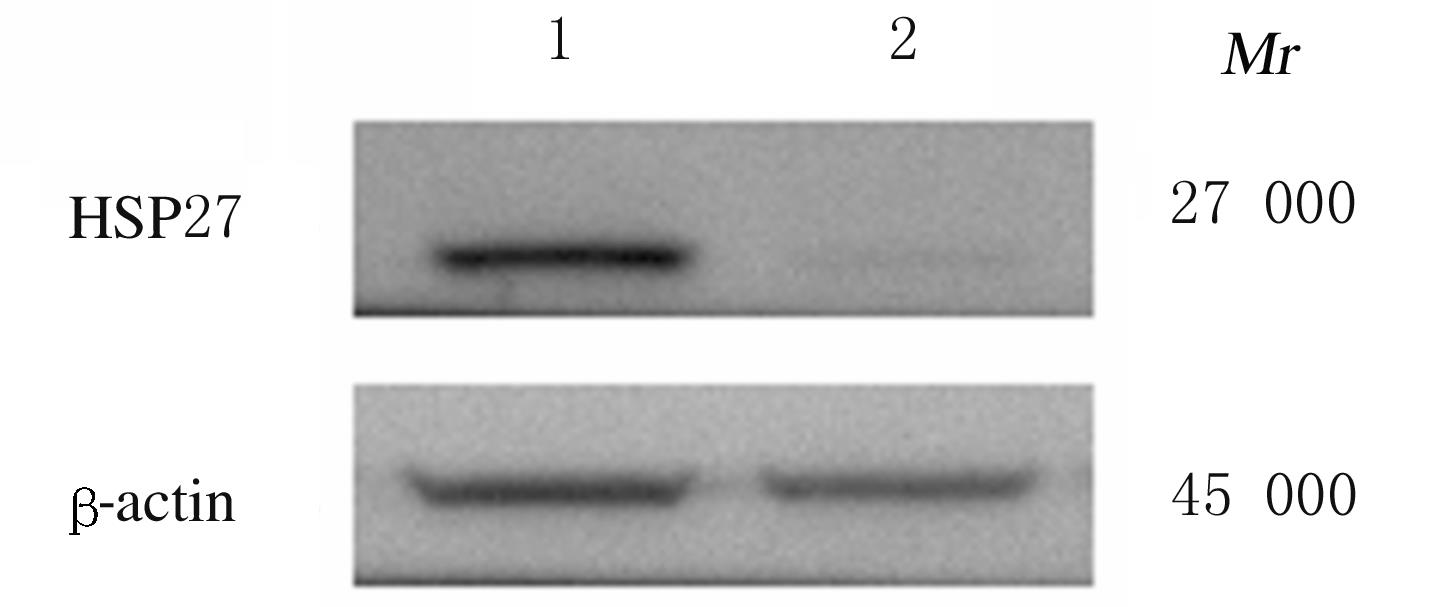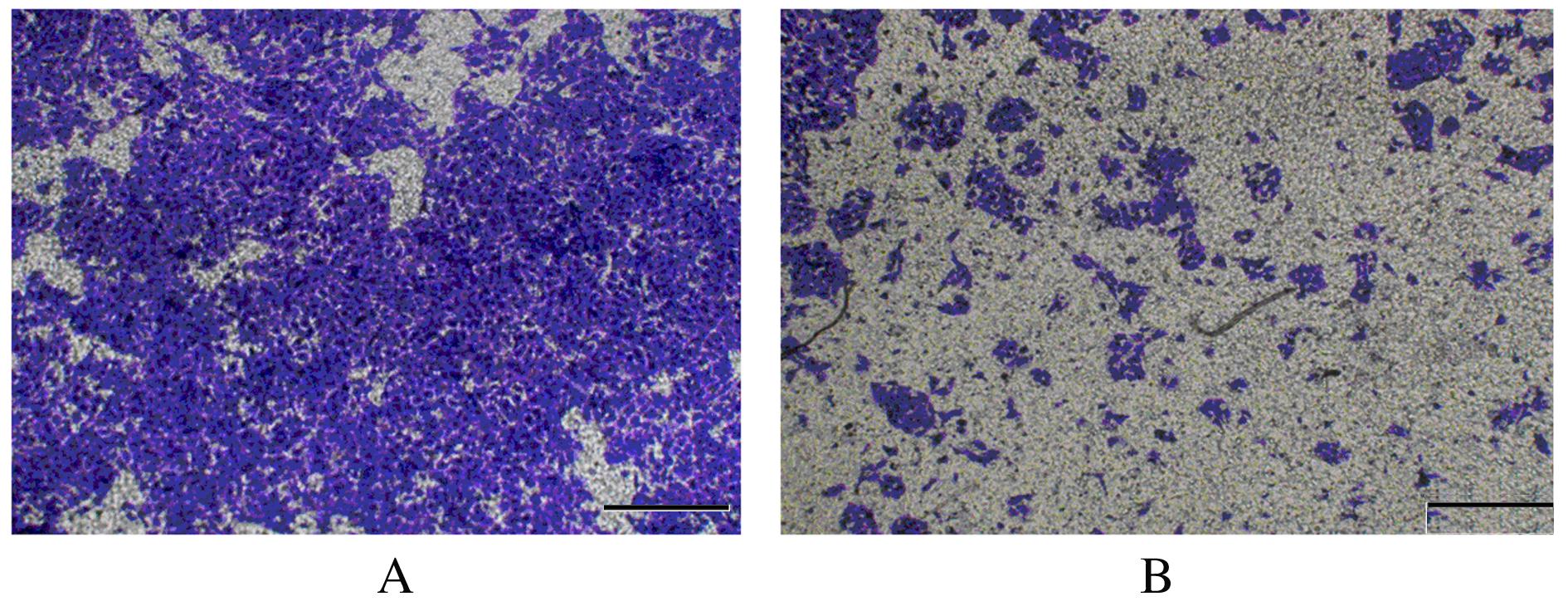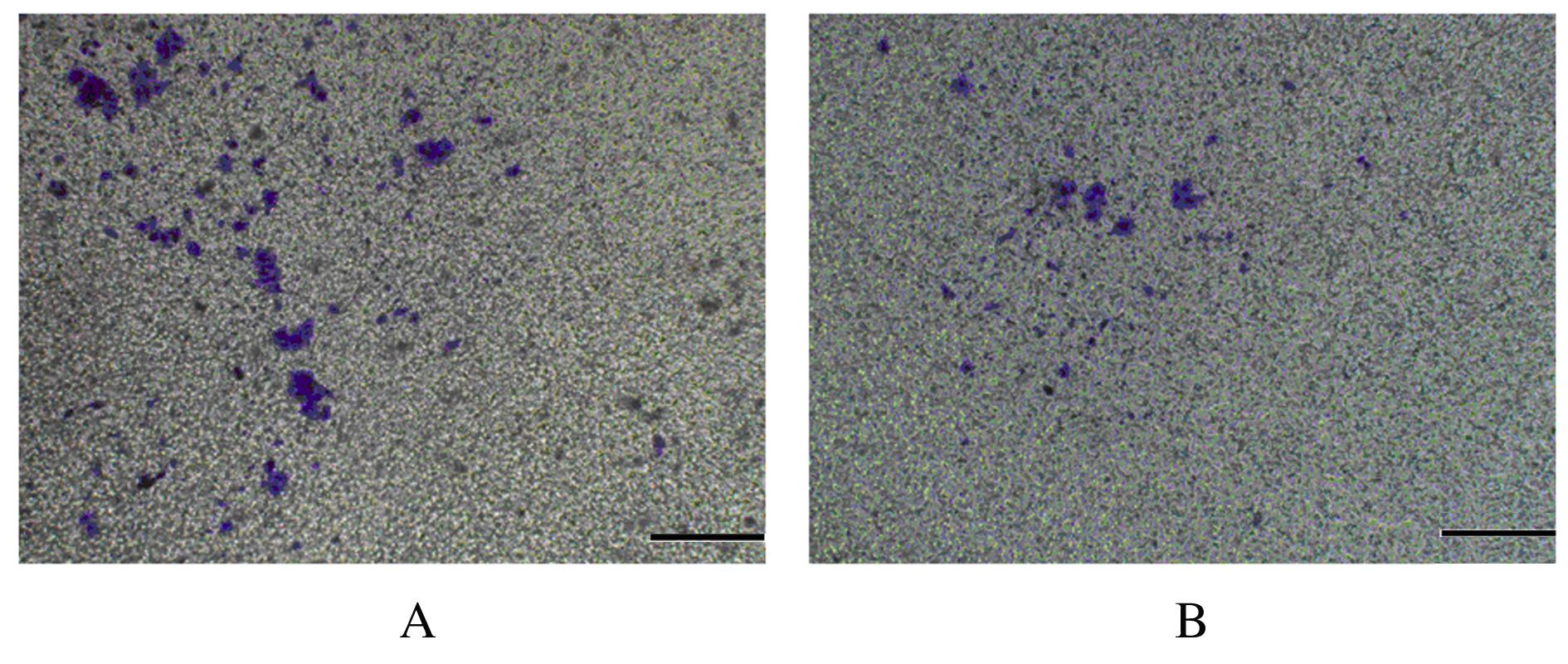Journal of Jilin University(Medicine Edition) ›› 2021, Vol. 47 ›› Issue (4): 971-977.doi: 10.13481/j.1671-587X.20210421
• Research in basic medicine • Previous Articles Next Articles
Effects of targeted silencing of heat shock protein 27 on invasion and migration of oral squamous cell carcinoma CAL27 cells and their mechanisms
Juan CAO1,Weibo LI1,Xiu GUO2,Bo LI1,3( ),Chunling DONG2(
),Chunling DONG2( )
)
- 1.Experimental Teaching Center,Stomatology Hospital,Jilin University,Changchun 130021,China
2.Department of Respiratory Medicine,Second Hospital,Jilin University,Changchun 130041,China
3.Experimental Teaching Center,Affiliated Stomatological Hospital,School of Stomatology,China Medical University,Key Laboratory of Oral Diseases of Liaoning Province,Shenyang 110002,China
-
Received:2020-10-30Online:2021-07-28Published:2021-07-22 -
Contact:Bo LI,Chunling DONG E-mail:972638190@qq.com;cldong@jlu.edu.cn
CLC Number:
- R739.8
Cite this article
Juan CAO,Weibo LI,Xiu GUO,Bo LI,Chunling DONG. Effects of targeted silencing of heat shock protein 27 on invasion and migration of oral squamous cell carcinoma CAL27 cells and their mechanisms[J].Journal of Jilin University(Medicine Edition), 2021, 47(4): 971-977.
share this article
| 1 | CARNIELLI C M, MACEDO C C S, DE ROSSI T, et al. Combining discovery and targeted proteomics reveals a prognostic signature in oral cancer[J]. Nat Commun, 2018, 9(1):3598. |
| 2 | CAI H, LI J, ZHANG Y, et al. LDHA promotes oral squamous cell carcinoma progression through facilitating glycolysis and epithelial-mesenchymal transition[J]. Front Oncol, 2019, 9: 1446. |
| 3 | SIEGEL R L, MILLER K D, JEMAL A. Cancer statistics, 2020[J]. CA Cancer J Clin, 2020, 70(1): 7-30. |
| 4 | BRAY F, FERLAY J, SOERJOMATARAM I, et al. Global cancer statistics 2018: GLOBOCAN estimates of incidence and mortality worldwide for 36 cancers in 185 countries[J]. CA Cancer J Clin, 2018, 68(6): 394-424. |
| 5 | HUANG S H, O’SULLIVAN B. Overview of the 8th edition TNM classification for head and neck cancer[J]. Curr Treat Options Oncol, 2017, 18(7): 40. |
| 6 | FERLAY J, SOERJOMATARAM I, DIKSHIT R, et al. Cancer incidence and mortality worldwide: sources, methods and major patterns in GLOBOCAN 2012[J]. Int J Cancer, 2015, 136(5): E359-E386. |
| 7 | NORTON J A, WEINBERGER P M, WALLER J L, et al. Significance of HSPB1 expression in head and neck squamous cell carcinoma: a meta-analysis of published literatures[J]. Laryngoscope, 2010, 120(): S172. |
| 8 | ZHANG J F, DONG W, MENG Y F, et al. Proteomic analysis of serum deprivation in tongue squamous cell carcinoma[J]. Mol Med Rep, 2017, 16(6): 9323-9330. |
| 9 | HUANG Z C, LI H, SUN Z Q, et al. Distinct prognostic roles of HSPB1 expression in non-small cell lung cancer [J]. Neoplasma, 2018, 65(1): 161-166. |
| 10 | BANERJEE S, LIN C F L, SKINNER K A, et al. Heat shock protein 27 differentiates tolerogenic macrophages that may support human breast cancer progression[J]. Cancer Res, 2011, 71(2): 318-327. |
| 11 | SHIOTA M, BISHOP J L, NIP K M, et al. Hsp27 regulates epithelial mesenchymal transition, metastasis, and circulating tumor cells in prostate cancer[J]. Cancer Res, 2013, 73(10): 3109-3119. |
| 12 | ERNST B P, WIESMANN N, GIERINGER R, et al. HSP27 regulates viability and migration of cancer cell lines following irradiation[J]. J Proteom, 2020, 226: 103886. |
| 13 | GUO Y, ZIESCH A, HOCKE S, et al. Overexpression of heat shock protein 27 (HSP27) increases gemcitabine sensitivity in pancreatic cancer cells through S-phase arrest and apoptosis[J]. J Cell Mol Med, 2015, 19(2): 340-350. |
| 14 | HO A S, KIM S, TIGHIOUART M, et al. Metastatic lymph node burden and survival in oral cavity cancer[J]. J Clin Oncol, 2017, 35(31): 3601-3609. |
| 15 | TWEEDLE E M, KHATTAK I, ANG C W, et al. Low molecular weight heat shock protein HSP27 is a prognostic indicator in rectal cancer but not colon cancer [J]. Gut, 2010, 59(11): 1501-1510. |
| 16 | SÖDERSTRÖM H K, KAUPPI J T, OKSALA N, et al. Overexpression of HSP27 and HSP70 is associated with decreased survival among patients with esophageal adenocarcinoma[J]. World J Clin Cases, 2019, 7(3): 260-269. |
| 17 | LIANG C, XU Y, GE H, et al. The clinicopathological and prognostic value of HSP27 in hepatocellular carcinoma: a systematic review and meta-analysis[J]. Onco Targets Ther, 2018, 11: 1293-1303. |
| 18 | 李红波,苏 磊,林新峰,等. HSP27在热打击致F98细胞氧化应激损伤及细胞凋亡中的作用[J]. 解放军医学杂志, 2018,43(10): 854-859. |
| 19 | WETTSTEIN G, BELLAYE P S, MICHEAU O,et al. Small heat shock proteins and the cytoskeleton: an essential interplay for cell integrity? [J]. Int J Biochem Cell Biol, 2012, 44(10): 1680-1686. |
| 20 | KE J, WU G, ZHANG J, et al. Melanoma migration is promoted by prion protein via Akt-hsp27 signaling axis[J]. Biochem Biophys Res Commun,2020,523(2):375-381. |
| 21 | HAN L, JIANG Y, HAN D, et al. Hsp27 regulates epithelial mesenchymal transition, metastasis and proliferation in colorectal carcinoma[J]. Oncol Lett, 2018, 16(4): 5309-5316. |
| 22 | TAO D, ZHANG Z, LIU X, et al. LncRNA HOTAIR promotes the invasion and metastasis of oral squamous cell carcinoma through metastasis-associated gene 2[J]. Mol Carcinog, 2020, 59(4): 353-364. |
| 23 | REN J, LIANG Q. HMGB1 promotes the proliferation and invasion of oral squamous cell carcinoma via activating epithelial-mesenchymal transformation [J]. Biocell, 2019, 43(3): 199-205. |
| 24 | 杨春雪,张 圆,汪园圆,等.肿瘤内神经新生在口腔鳞状细胞癌进展中的作用及机制[J].同济大学学报(医学版),2019,40(2):162-168. |
| 25 | LING Z, YANG X, CHEN X, et al. CCL2 promotes cell migration by inducing epithelial-mesenchymal transition in oral squamous cell carcinoma[J]. J Oral Pathol Med, 2019, 48(6): 477-482. |
| 26 | CHOI S K, KAM H, KIM K Y, et al. Targeting heat shock protein 27 in cancer: a druggable target for cancer treatment? [J]. Cancers, 2019, 11(8):1195. |
| 27 | QU Y, HE Y, YANG Y, et al. ALDH3A1 acts as a prognostic biomarker and inhibits the epithelial mesenchymal transition of oral squamous cell carcinoma through IL-6/STAT3 signaling pathway[J]. J Cancer, 2020, 11(9): 2621-2631. |
| 28 | YAO K, HE L Y, GAN Y, et al. HMGN5 promotes IL-6-induced epithelial-mesenchymal transition of bladder cancer by interacting with Hsp27 [J]. Aging, 2020, 12(8): 7282-7298. |
| 29 | SRIVATS S, BALASURIYA D, PASCHE M, et al. Sigma1 receptors inhibit store-operated Ca2+ entry by attenuating coupling of STIM1 to Orai1[J]. J Cell Biol, 2016, 213(1): 65-79. |
| 30 | HUANG C Y, WEI P L, CHEN W Y, et al. Silencing heat shock protein 27 inhibits the progression and metastasis of colorectal cancer (CRC) by maintaining the stability of stromal interaction molecule 1 (STIM1) proteins[J]. Cells, 2018, 7(12): 262. |
| 31 | FANG Z H, LIANG W J, LUO L B. HSP27 promotes epithelial-mesenchymal transition through activation of the β-catenin/MMP3 pathway in pancreatic ductal adenocarcinoma cells [J]. Transl Cancer Res,2019, 8(4): 1268-1278. |
| 32 | CORDONNIER T, BISHOP J L, SHIOTA M, et al. Hsp27 regulates EGF/β-catenin mediated epithelial to mesenchymal transition in prostate cancer[J]. Int J Cancer, 2015, 136(6): E496-E507. |
| [1] | Zhijuan WANG,Mingshu ZHANG,Liping YE. Effects of platelet-derived growth factor D on proliferation, migration and invasion of lung cancer H1299 cells through ERK signaling pathway and their mechanisms [J]. Journal of Jilin University(Medicine Edition), 2022, 48(4): 898-904. |
| [2] | Weibo LI,Juan CAO,Xiu GUO,Chunling DONG,Bo LI. Promotion effect of tumor associated macrophages-derived IL-6 on invasion and migration of oral squamous cell carcinoma Cal27 cells by upregulating LIF expression in tumor cells [J]. Journal of Jilin University(Medicine Edition), 2022, 48(4): 946-953. |
| [3] | Yandi MA,Xiangyun LU,Shangfeng HE,Xueyan YU,Yunhua HU,Haixia GAO,Yunzhao CHEN,Jie YU,Wenjie WANG,Feng LI,Xiaobin CUI. Expression of m6A methylation binding protein YTHDF2 in esophageal carcinoma tissue and its effect on proliferation and migration of esophageal carcinoma cells [J]. Journal of Jilin University(Medicine Edition), 2022, 48(4): 962-970. |
| [4] | Guowu WANG,Yuan YAO,Yu ZHANG,Na XU,Fang LIU. Inhibitory effect of miR-152 on proliferation and invasion of endometrial carcinoma cells by reducing low-density lipoprotein receptor expression [J]. Journal of Jilin University(Medicine Edition), 2022, 48(3): 591-599. |
| [5] | Cuilan LIU,Fengai HU,Jing LIU,Dan WANG,Changyun QIU,Dunjiang LIU,Di ZHAO. Effect of adiponectin receptor agonist AdiopRon on biological behaviors of glioma cells and its mechanism [J]. Journal of Jilin University(Medicine Edition), 2022, 48(3): 702-710. |
| [6] | Zhuangzhi WU,Xiaoning HE,Siqi CHEN. Inhibitory effect of miR-124-3p on proliferation and invasion of oral squamous cell carcinoma cells and its mechanism [J]. Journal of Jilin University(Medicine Edition), 2022, 48(3): 718-727. |
| [7] | Xiaoyan LI,Wei ZHANG,Jie HE. Promotion effect of REG1A on proliferation and migration of lung adenocarcinoma cells by regulating Wnt/β-catenin signaling pathway [J]. Journal of Jilin University(Medicine Edition), 2022, 48(2): 444-453. |
| [8] | Zetai WANG,Dandan LOU,Yan PENG,Daoqi ZHU,Aiwu LI,Fengying GONG,Ying LYU,Qin FAN. Establishment of zebrafish xenograft model of nasopharyngeal carcinoma and inhibitory effect of curcumin on CNE-2 cells [J]. Journal of Jilin University(Medicine Edition), 2022, 48(1): 9-17. |
| [9] | Runhong MU,Yijiu AI,Yupeng LI,Rui LIN,Siping YE,Fang MA,Xiao GUO. Expression of recombinant human IL-17A in gastric cancer tissue and its effects on proliferation, invasion, migration and apoptosis of gastric cancer BGC-823 cells [J]. Journal of Jilin University(Medicine Edition), 2021, 47(6): 1510-1517. |
| [10] | Yajie CAO,Xiaohong BAO,Shuzhen LI,Haiying GENG,Zengxiaorui CAI,Chunmei DAI,Ning LI. Effects of insulin-like growth factor 1 receptor inhibitor NVP-AEW541 on proliferation, migration and invasion of ESCC cells [J]. Journal of Jilin University(Medicine Edition), 2021, 47(5): 1131-1138. |
| [11] | Lisong CHEN,Hui FANG,Hefei WANG,Chengyuan HE,Xiaodong GAI,Chun LI. Effects of Notch1 signaling pathway on invasion and cisplatin resistance of lung adenocarcinoma cells and their mechanisms [J]. Journal of Jilin University(Medicine Edition), 2021, 47(5): 1171-1177. |
| [12] | Runhong MU, Xinzhu LIU, Rui LIN, Yupeng LI, Luyao WANG, Chunyu WANG, Xiao GUO. Effect of PRDX6 over-expression of proliferation, invasion and migration of liver cancer cells and its molecular mechanism [J]. Journal of Jilin University(Medicine Edition), 2021, 47(3): 559-565. |
| [13] | Cuilan LIU, Jianjun LI, He JIANG, Jing LIU, Dan WANG, Chen LI, Di ZHAO. Effect of urolithin B on biological behaviors of human glioblastome U118 MG cells and its mechanism [J]. Journal of Jilin University(Medicine Edition), 2021, 47(3): 566-574. |
| [14] | Bo MA, Jiangang LI, Jun WANG, Junli HOU, Liang LI. Promotion effect of miR-106b on invasion and migration of colon cancer cells through targeting TGF-β/Smad pathway [J]. Journal of Jilin University(Medicine Edition), 2021, 47(3): 630-636. |
| [15] | Xiaohui LI, Ziwei QU, Xin LU, Qingbin MENG, Huatao CHEN, Jun REN, Chengpei TAN. Regulatory effect of exosomes carrying miR-196b-5p derived from bone marrow mesenchymal stem cells on biological characteristics of colon cancer cells [J]. Journal of Jilin University(Medicine Edition), 2021, 47(3): 660-668. |













